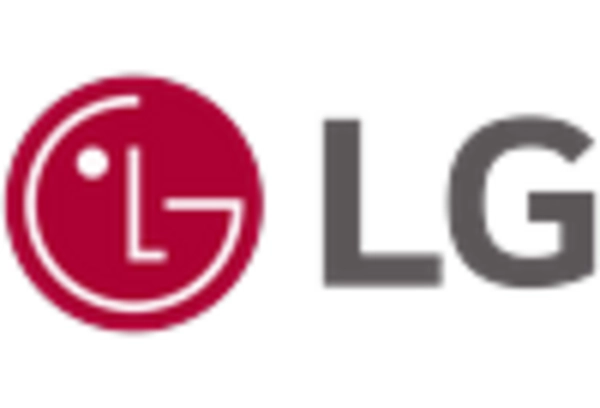Growth of Streaming Services
The Audio Visual Hardware Market is positively impacted by the growth of streaming services, which have transformed how content is consumed. As more consumers turn to streaming platforms for entertainment, the demand for high-quality audio visual hardware has surged. This trend is reflected in the increasing sales of home theater systems, soundbars, and high-definition displays, as consumers seek to replicate the cinematic experience at home. Market data suggests that the home entertainment segment is projected to expand significantly, driven by the proliferation of streaming services. Consequently, this growth in streaming services is likely to continue fueling demand for advanced audio visual hardware, thereby enhancing the overall landscape of the Audio Visual Hardware Market.
Advancements in Audio Technology
The Audio Visual Hardware Market is significantly influenced by advancements in audio technology, particularly in the realm of sound quality and clarity. Innovations such as spatial audio and high-definition sound systems are becoming more accessible, leading to enhanced user experiences in both personal and professional settings. The demand for high-quality audio solutions is evident, with the market for professional audio equipment expected to reach substantial figures in the coming years. These advancements not only cater to the entertainment sector but also find applications in corporate environments, where clear audio is crucial for effective communication. As audio technology continues to evolve, it is likely to drive further growth within the Audio Visual Hardware Market, as consumers and businesses alike seek superior audio experiences.
Rising Demand for Interactive Displays
The Audio Visual Hardware Market experiences a notable surge in demand for interactive displays, driven by the increasing adoption of technology in educational and corporate environments. Interactive displays facilitate engaging presentations and collaborative learning experiences, which are essential in modern classrooms and meeting rooms. According to recent data, the market for interactive displays is projected to grow at a compound annual growth rate of approximately 10% over the next five years. This trend indicates a shift towards more dynamic and participatory methods of communication, enhancing the overall effectiveness of presentations. As organizations seek to improve engagement and productivity, the integration of interactive displays into their audio visual setups becomes increasingly prevalent, thereby propelling the growth of the Audio Visual Hardware Market.
Increased Investment in Event Production
The Audio Visual Hardware Market is witnessing increased investment in event production, as organizations recognize the importance of high-quality audio visual setups for successful events. From corporate conferences to live concerts, the demand for professional-grade audio visual equipment is on the rise. Recent statistics indicate that the event production market is expected to grow significantly, with a substantial portion of this growth attributed to the need for advanced audio visual solutions. Companies are increasingly allocating budgets for state-of-the-art equipment to enhance audience engagement and create memorable experiences. This trend not only benefits the event production sector but also stimulates growth in the Audio Visual Hardware Market, as more businesses seek to invest in top-tier audio visual technologies.
Emergence of Virtual Reality and Augmented Reality
The Audio Visual Hardware Market is experiencing a transformative phase with the emergence of virtual reality (VR) and augmented reality (AR) technologies. These innovations are reshaping how users interact with audio visual content, creating immersive experiences that were previously unattainable. The market for VR and AR hardware is expected to witness substantial growth, as applications in gaming, education, and training become more prevalent. This shift towards immersive technologies is prompting consumers and businesses to invest in specialized audio visual equipment that can support these experiences. As the demand for VR and AR solutions continues to rise, it is likely to drive further advancements and investments within the Audio Visual Hardware Market, fostering a new era of interactive content consumption.

















Leave a Comment